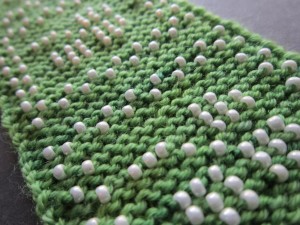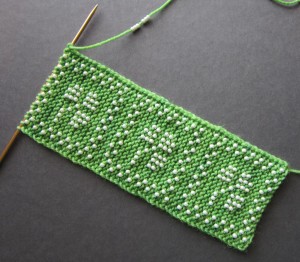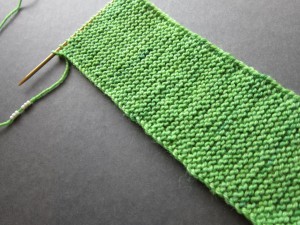Do you hate to purl?
Last March we had a just-for-fun poll with slightly more than 45% of members who responded falling into the categories of “I hate to purl” or “I don’t hate to purl, but I’d rather knit”.
I myself don’t really hate to purl, but must admit I do prefer to knit. If you fall into this category or the “I hate to purl” camp, you will love beaded garter stitch. Either way, I hope you enjoy making this month’s Irish Coffee Cozy.
The cozy is worked in garter stitch (i.e. knit every row) with a tidy, stretchy slipped stitch chain selvedge at each edge. You will be working back and forth to make a strip of fabric which is later joined into a tube.
After you have cast on your 18 stitches, you are ready to start knitting the beaded Shamrock Motif using either the charted or written instructions. Reminder: If you use long tail cast on instead of the simple half-hitch cast on, then start with row 2 instead of row 1.
Beads are placed on wrong side rows, since beads want to go to the bumpy side of the stitch. This makes the beaded pattern show up on the right side (i.e. outer-side of the fabric when completed/used).
In case working Beaded Garter Stitch is new to you, or if you’d like to review, there are pictures, tips & techniques in this article from last year’s Beading Hearts Friendship Bracelet KAL.
Beaded garter stitch is not reversible
Whereas regular garter stitch is reversible, beaded garter stitch is not.
The picture above is what the almost-completed strip of beaded garter stitch looks like for Irish Coffee Cozy as viewed from the beaded side.
And below is what it looks like when viewed from the wrong side; i.e. the beads do not show up at all and the fabric just looks like garter stitch.
Beaded garter stitch is even-count
Because the gauge of garter stitch is basically 2 rows = 1 stitch, the fabric is a great canvas on which to design even-count designs or even adapt simple even-count charts from other fiber disciplines such as cross-stitch, needlepoint and filet crochet.
Does this sound familiar? Coincidentally, last month’s KAL project for knitted filet lace was also adaptable to even-count designs.
Beaded garter stitch is horizontally flipped
If you compare the orientation of the shamrock chart image in your pattern instructions, you see how working from the wrong side results in a horizontally flipped image when viewed from the right side of the beaded fabric.
Tip: If you are designing your own beaded garter stitch motifs that have a definite left and right, remember to keep this in mind by mirroring your chart.
The “rest row” of beaded garter stitch
Since beads are worked into the knitting on the wrong side rows, those rows are the “pay attention” rows. The right side rows are then the plain knitting “rest rows” (whereas in lace knitting, the wrong side rows are usually the “rest rows”).
Making beaded garter stitch more elastic
Just like regular garter stitch, beaded garter stitch is inherently elastic. If you working with an inelastic fiber like cotton, you can boost the elasticity by knitting into the back loop of stitches on the return non-beaded row rather than plain knit. This also has the advantage of further locking the beads firmly into the fabric.
Note that knitting into the back loop does subtly change the gauge since you are twisting the stitch, which also tightens it a bit. But that is not really a problem for what we are doing here.





 HeartStrings FiberArts
HeartStrings FiberArts Knitting Bits of Lace on Facebook
Knitting Bits of Lace on Facebook Ravelry Store
Ravelry Store